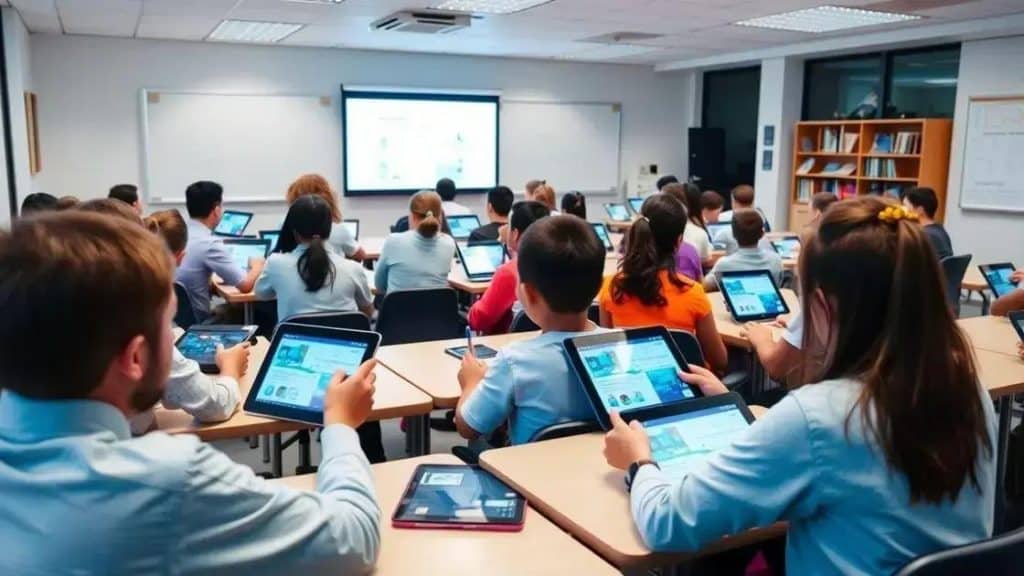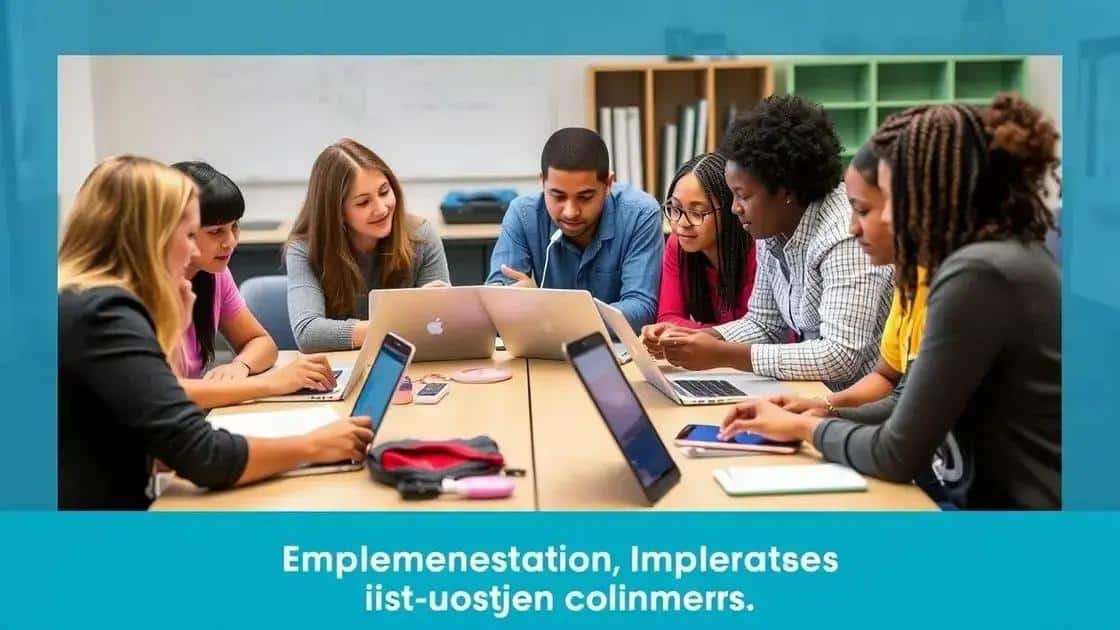Ability school technology upgrades for smarter learning

Upgrading technology in schools enhances student engagement, provides access to personalized learning tools, and prepares students for a technology-driven future while addressing challenges like funding and staff training.
Ability school technology upgrades are transforming the way students learn and interact in the classroom. Have you ever wondered how these advancements can shape education? Let’s dive into the exciting world of school technology!
Understanding technology upgrades in schools
Understanding the importance of technology upgrades in schools is essential for fostering a dynamic learning environment. As education evolves, so do the tools needed to engage students and enhance their learning experience.
With rapid advancements in technology, schools are tasked with continuously updating their resources to improve teaching methods and student outcomes. It’s vital to recognize how these upgrades can significantly impact the educational landscape.
The impact of technology upgrades
Technology upgrades in schools can transform classrooms into interactive learning environments. By integrating tools like smartboards, tablets, and educational software, educators can facilitate more engaging lessons that cater to various learning styles.
Key benefits of technology upgrades
- Enhanced student engagement through interactive lessons.
- Improved access to resources and educational materials.
- Fostering collaboration among students and teachers.
- Personalized learning experiences that meet individual student needs.
These upgrades also promote essential skills such as critical thinking and digital literacy, preparing students for a tech-driven world. Moreover, when schools invest in modern technology, they signal their commitment to providing quality education, which can boost enrollment and community support.
It’s important to involve all stakeholders, including teachers, parents, and students, in the decision-making process when planning for technology upgrades. This collaboration ensures that the selected tools align with educational goals and effectively meet the needs of the school community.
Ultimately, a successful upgrade strategy is one that includes ongoing training for teachers and continuous evaluation of the technology’s effectiveness in the classroom. By making smart choices and prioritizing technology upgrades, schools can create enriching environments that empower students to thrive.
Benefits of upgrading technology in education
Upgrading technology in education brings numerous benefits that can enhance the learning experience for students and teachers alike. By integrating modern tools, schools create an environment that fosters creativity and better engagement.
One significant advantage of upgrading is the ability to access a wealth of information online. With upgraded systems and devices, students can easily research and find resources that were once difficult to obtain. This access encourages critical thinking and the ability to analyze various viewpoints.
Improved student engagement
When technology is modernized in schools, students are naturally drawn to interactive tools. This engagement is vital for maintaining interest and motivation during lessons. For instance, using virtual reality can turn science lessons into exciting experiences, transporting students to different environments and enhancing their understanding.
Collaboration and communication
- Enhanced collaboration between students through shared projects and tools.
- Improved communication between teachers and parents with digital platforms.
- Access to online forums and discussion boards for deeper learning.
- Encouraged teamwork, as students can work collectively on assignments using technology.
Moreover, upgrading technology prepares students for the modern workforce. Familiarity with advanced tools builds essential skills necessary for future careers. When students learn with current technology, they are better equipped for the challenges they will face.
In addition, educators benefit from streamlined processes. With upgraded software and hardware, lesson planning and grading can be more efficient and less time-consuming. This allows teachers to focus on delivering quality instruction and providing personalized support to each student.
Furthermore, schools that prioritize technology upgrades are more likely to attract families. Parents value institutions that prepare their children for a tech-centric world, which can lead to increased enrollment and community support.
How to implement technology changes effectively

Implementing technology changes effectively in schools requires careful planning and collaboration among all stakeholders. To start, it’s crucial to assess the current technological landscape and identify areas that need improvement.
Engaging the community is vital during this process. Involving teachers, students, and parents in discussions about desired technology can lead to better decisions that suit everyone’s needs. Regular meetings can help gather input and foster a sense of ownership.
Step-by-step approach
A step-by-step approach often works best for implementing changes. Begin by establishing clear goals for what the school hopes to achieve through the upgrades. Ensuring everyone understands these goals can build excitement and accountability.
Key steps to success
- Conduct surveys to gather feedback and assess needs.
- Research and select appropriate technology solutions that fit the budget.
- Prepare a detailed implementation plan that includes training for teachers.
- Establish a timeline with clear milestones to track progress.
Training is an essential element in this process. Teachers must feel comfortable and confident using new technologies to integrate them effectively into their lessons. Providing professional development sessions can help achieve this goal.
Once the new systems are in place, ongoing support and maintenance are crucial. Schools should designate tech support staff who can assist with any issues and ensure that tools operate smoothly.
Monitoring the effectiveness of the changes is also necessary. Regular assessments can highlight what works well and what may need adjustments. This process allows schools to stay adaptable and continuously improve their technological integration.
Challenges faced during school technology upgrades
Implementing technology upgrades in schools can be a rewarding process, but it also comes with a range of challenges. Understanding these challenges is vital for a smooth transition to a more modern educational environment.
One major challenge is securing funding. Many schools operate on tight budgets, making it difficult to allocate necessary resources for upgrades. Finding grants or community support can ease this burden but requires effort and creativity.
Resistance to change
Another significant obstacle is resistance to change. Some staff members may feel uncomfortable with new technologies, fearing that they will complicate their teaching methods. To overcome this, schools can provide robust training programs that empower teachers to feel confident and excited about using new tools.
Technical issues and infrastructure
- Inadequate internet connectivity can hinder the use of new tools and resources.
- Hardware compatibility issues may arise, requiring additional investments.
- Technical difficulties can distract from teaching and learning in the classroom.
- Lack of ongoing support can leave teachers frustrated when problems arise.
Moreover, keeping up with the rapid pace of technological change presents another challenge. Schools must continually assess and adapt to new advancements, which can be overwhelming for staff and administrators alike. Effective planning and a commitment to continual improvement can help mitigate this issue.
Finally, evaluating the effectiveness of new technologies can be complex. Schools need clear metrics to measure success and determine if the upgrades are achieving desired outcomes. Regular feedback from students and teachers can provide valuable insights into what’s working and what needs adjustment.
Future trends in educational technology
The future of educational technology is bright, with many exciting trends set to reshape how students learn and teachers teach. As technology continues to evolve, schools must stay ahead to provide the best educational experiences.
One major trend is the increased use of artificial intelligence (AI) in the classroom. AI can offer personalized learning experiences, adapting to each student’s needs and pace. This tailored approach can enhance student engagement and improve learning outcomes.
Blended learning environments
Another growing trend is the shift towards blended learning environments, which combine traditional teaching methods with online resources. This mix allows students to take more control over their learning, accessing materials at their convenience while still benefiting from face-to-face interactions.
Data-driven insights
- Schools are implementing data analytics tools to track student progress.
- This technology helps identify areas where students may need extra support.
- Teachers can make informed decisions based on real-time data.
- Data can also enhance individualized instruction plans.
Moreover, emerging technologies, such as virtual reality (VR) and augmented reality (AR), are expected to make significant impacts. These tools can create immersive learning experiences that transport students to different places or times, enriching their understanding of complex subjects.
Additionally, the importance of cybersecurity in education will grow. As more educational institutions adopt technology, ensuring the safety of student data will be essential. Schools will need to implement robust security measures to protect against cyber threats.
Collaboration tools are also on the rise, facilitating communication among students, teachers, and parents. Platforms that enable real-time feedback and shared resources will improve the overall learning experience.
FAQ – Frequently Asked Questions about Educational Technology Upgrades
What are the main benefits of upgrading technology in schools?
Upgrading technology in schools enhances student engagement, provides access to a wealth of information, and supports personalized learning experiences.
What challenges can schools face during technology upgrades?
Schools may face challenges like funding limitations, resistance to change from staff, technical issues, and the need for ongoing training and support.
How can educators ensure successful technology implementation?
Educators can ensure success by engaging the community, providing thorough training, setting clear goals, and establishing a step-by-step implementation plan.
What future trends should schools watch in educational technology?
Schools should be aware of trends like the use of AI for personalized learning, blended learning environments, data-driven insights, and the integration of virtual and augmented reality.





